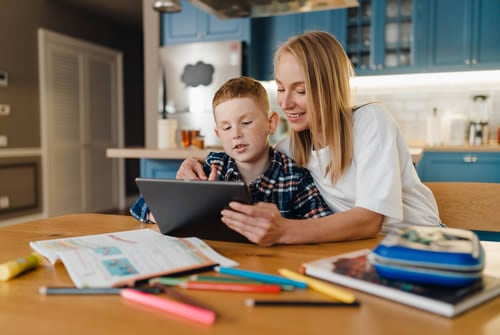Visual resources can bring a sense of security and comfort to autistic students. The world can feel confusing or bewildering for autistic learners, and life may feel too noisy, too abstract, or too disorderly. Seeing something visible in the classroom or learning environment which solidly represents a part of their day can change some of that uncertainty into a concrete reality.
According to Autism Parenting Magazine:
“Visual supports for autism play a crucial role in helping children navigate daily life, communicate effectively, and build essential skills.” https://www.autismparentingmagazine.com/benefits-of-autism-visual-supports/
What are Visual Supports and Why are They Important?

A visual support is anything that can be clearly seen by the student and helps them to grasp their routine, their lesson targets and/or make sense of their environment in general. This could be:
- A schedule of the day
- A learning task in colourful print (e.g. 5 x table)
- Flashcards
- Photos
The use of visual aids can make the world feel more stable for autistic students because the visuals can help them understand what is happening, especially in these areas:
- Communicating expectations
- Accessing information
- Planning a task
- Processing new knowledge
How Visual Supports Can Help a Child with Autism

These are some ideas for visual aids which you can use with autistic children:
Now/Next Board
SEN Tutor, Sammie often uses a “Now” and “Next” board to offer clarity around routines and boost autistic children’s motivation to learn:
“These can be shown to a child to prepare them for what is coming next. It can also motivate a child to complete a task, as they know they have a preferred activity approaching. One child I worked with would happily complete a maths activity if they knew that the next task was some fun time on their iPad.”
Colourful timetables
A clear illustration of the daily schedule can be very reassuring for autistic learners. Why not use fun symbols to denote activities, such as a set of numbers for a maths activity or fruits for snack time? A routine plan that displays each stage of the day can help autistic children feel safe.
Social Stories
Use visual social storytelling to help autistic children navigate life events. Short, one-off stories or scenarios can be used to make events that might arise in school more predictable. Stories can also help autistic children to understand what kinds of behaviour might be expected in these situations.
For example, a social story could describe how to share equipment appropriately or play together successfully and can help autistic children learn the rules of behaviour.
Strewing/Making Choices
Strewing is the practice of offering a task without suggesting it verbally. You allow a child to see their options and then choose, without the stress of a fixed agenda. This strategy is often used with autistic children who have an additional PDA profile (Pathological Demand Avoidance). You can use visual displays to present the available options. This gives autistic pupils more autonomy over their learning by helping them state their preferences.
Task planners
These can be used to clearly display the stages that need to be fulfilled to complete a project.
Presenting a clear list to a child can boost their independence; once it has been explained, they may often simply follow their list, gaining a sense of achievement as they tick off what they have completed.
Communication programmes e.g. Makaton
Makaton is a communication programme that uses speech with signs (signals) and symbols (visual images) to help children with additional communication or learning needs to express themselves.
Systems like this can help autistic children communicate by supporting their understanding of rules and expectations. The tool can also help autistic learners by promoting inner confidence that there are effective ways to communicate. This empowers them to move forward both educationally and socially.
How to Create Powerful Visual Supports for Autistic Students

For visual learning supports to make an impact, they should be:
- Bespoke – Made with an individual child in mind
- Clear – Language should be straightforward and accessible
- Basic – Images should be based on simple templates
- Visible – Resources should be easy to spot
Online Learning with Visual Aids

Visual resources are a very powerful tool for parents, teachers, or tutors who work online with autistic children. They can work on many levels, for example, by simplifying information, providing more structure, or providing more sensory input to those who need it.
Visuals can enhance the learning environment, particularly if learning is delivered remotely.
Colourful resources can also boost the interactive nature of an online lesson.
SEN tutor Sarah uses animal characters and online timers for tasks when working with her student virtually:
“The student knows the time limit for the task which engages and motivates them. Alongside the timer, there is a race between our visual characters (such as animals). Between us, we will often ‘choose’ a winner and then check at the end of the task to see whose character has won the race! I usually take the ‘race’ off the screen and show them just the last 10 seconds. My pupil’s motivation is two-fold; firstly, by the timers, and secondly, they are anticipating the result of the animal race.”
Next Steps: Using Visual Learning Aids for Children with Autism
Once a support is in place and you have found it to be effective, why not communicate this to other key people in the child’s life? Parents, carers, tutors and teachers can all benefit from implementing visual aids for autistic children.
Visual supports can play a big role in an autistic child’s journey, both at home and in school. Their use can instil self-assurance in a child and the belief that they can express their needs, access information, and be understood.
Useful Websites:
https://inclusiveteach.com/2017/02/15/using-visual-supports/#Visual_Supports_in_The_Classroom_For_Autistic_Children
https://www.autismtoolbox.co.uk/supporting-learners-and-families/effective-partnerships-and-communication/visual-supports/
https://www.adaptingforautism.com/visual-supports/using-visual-supports/
Please note: The information provided within this blog, by SENsational Tutors, is for general information purposes only. We appreciate that every person is unique and any advice/experiences mentioned within the content of each blog may not be reflective of your own personal experience. All information on the site is provided in good faith and is for educational informational purposes only. It is not a substitute for professional advice. Before taking any actions based upon such information, we encourage you to consult with appropriate professionals.



